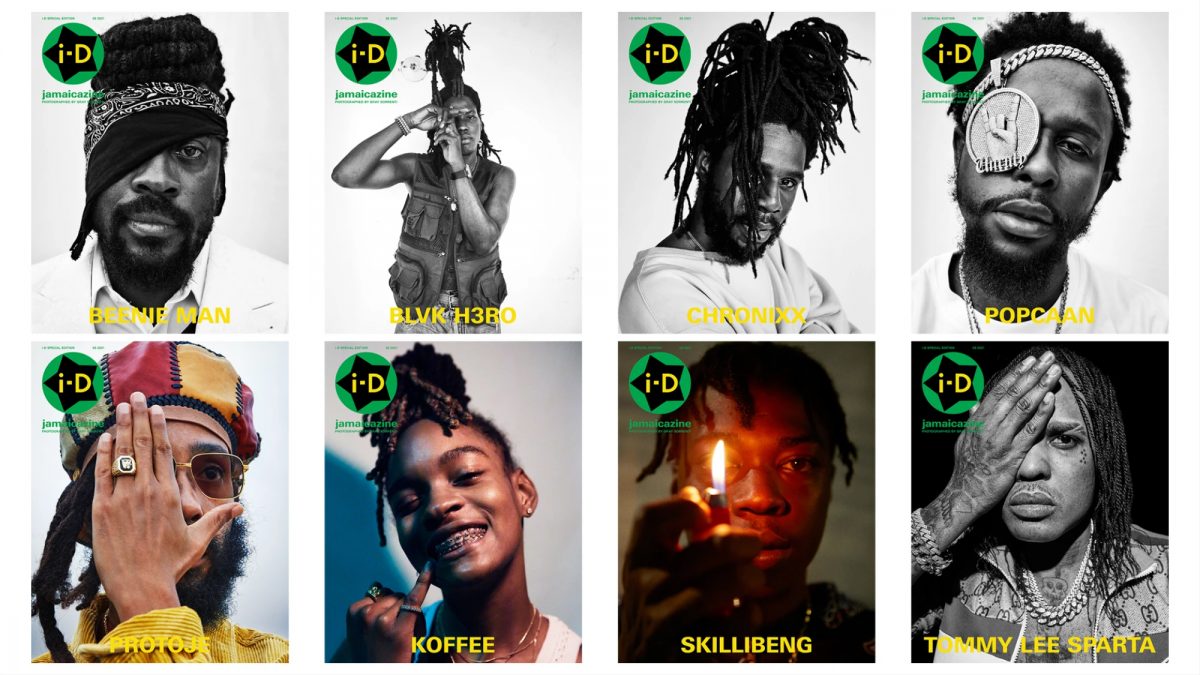i-D Magazine’s ‘Jamaicazine’ With 40 Dancehall, Reggae Artists Criticized For Its ‘White Gaze’

A new cover story, featuring Jamaica’s top Dancehall and Reggae acts, has the internet divided over its artistic direction, specifically the photography.
‘Jamaicazine’, i-D Magazine’s feature on established and emerging talents debuted to mixed reactions as fans felt the essence of the project could have been better captured by a Jamaican photographer. From Blvk H3ro to Beres Hammond, the scope of Dancehall/Reggae was on full display, however, the images have raised questions (and eyebrows) on black representation.
40 Jamaican artists including Sean Paul, Popocan, Koffee, Skillibeng, Chronixx, Buju Banton, Tommy Lee Sparta as well as stalwarts Yellowman and Burro Banton and more shared their views on the Jamaican music scene with Italian American photographer Gray Sorrenti for the latest issue, ‘Utopia in Dystopia’. Gray is the daughter of Mario Sorrenti, who has previously photographed Koffee for Calvin Klein and i-D Vice.
As touring and promotion remains shuttered due to the pandemic, the write-up is expected to garner plenty of publicity, but the Twitterverse, of course, had its concerns.
Addressing the piece dubbed, a “love letter to the island’s music”, many users sounded off about its white audience appeal and the missed opportunity to enhance the story through a local lens.
Introducing Jamaicazine! 🇯🇲
For i-D’s Spring issue, photographer Gray Sorrenti travelled to Jamaica to celebrate 40 musicians past and present, who have shaped a sound that has travelled from the island to the world.
Read their stories here: https://t.co/SnY9CQJBtN pic.twitter.com/TyH5en8I4X— i-D (@i_D) March 15, 2021
“Why couldn’t i-D have a Caribbean photographer shoot that jamaicazine issue? lmfao I don’t get it cool concept though”, wrote one user, while another said, “the part that’s probably tripping so many people up is the part where it’s called “jamaicazine”. it’s supposed to be an extension of cultural appreciation but it just comes off as colonizing. i-D, read the room next time.”
why couldn’t i-D have a Caribbean photographer shoot that jamaicazine issue? lmfao I don’t get it cool concept though
— JORDIOR (@jordiorsworld) March 16, 2021
“Sending foreign photographers to take intimate images of Jamaican culture for a foreign gaze… Big coloniser vibes,” said another.
It didn’t help matters that the spread was shot on Sorrenti’s iPhone 12 Pro Max, or her mention of the “earthquake, landslides, power and a water shortage”, that apparently occurred during her 10-day stay.
Another user noting a cliche in the story said, “they didn’t capture the essence of the artists in some [photos]. There’s a lot of covering of one eye as well.”
Writer and filmmaker Sharine Taylor tweeted her personal view that local talent be given preference when “editorializing places outside of [one’s] own geography” for an enhanced visual experience. “I have certainly done that for my editorials because it’s important for me to work alongside visual artists who are familiar with the landscape,” she said.
Photographer and Creative Director for Protoje, Yannick Reid tweeted “For those who ask: ‘it was her idea what could she have done?’ It takes a certain level of depth and selflessness to create an opportunity to share the spotlight. ‘Let me shoot alongside some other female Jamaican photographers that will add depth'”.
I’m sorry, but as much as I love the new i-D Jamaicazine, there were so many upcoming, talented local photographers who could’ve been a part of this. The sourcing is not spreading wide enough
— crybaby (@ambercashmere) March 15, 2021
https://twitter.com/likkleveganting/status/1371796942863360000
https://twitter.com/hoodbykenny/status/1371571110601490433
Ironically, VICE, i-D Magazine’s parent company, published a story in 2018 on this same issue, “stories around the black experience [not] being told for [or by] black people. Similarly, it touched on the ways in which the media executes “on behalf of white consumption”, or “for the sake of a white gaze”, relegating black creatives in a conversation that is ultimately their own.
It’s the reason that Latin sensation Maluma’s casting of local beauty queen Davina Bennett as his love interest in his visual EP, 7 Días en Jamaica was celebrated as a huge feat, as local talent is often overlooked in favor of house selections or more commercially viable options.
Still, Sorrenti claimed her intention for the project was “to bring together and celebrate the sounds of the past and present” which she delivered on the most part, visuals aside.
Grammy Award winner Sean Paul said he was “very proud of the ladies stepping up: Shenseea, Koffee, Spice, Ishawna”, when asked about Jamaica’s music scene, sentiments echoed by In.Digg. Nation crooner Sevana, along with his clash-less, ‘collaboration over confrontation’ mantra.
“More women pushing forward than we’ve ever seen in the history of Jamaica. Less beef, less rivalries. Dancehall culture is built on rivalry. On clashing. On one killer dub. But there’s a lot of emphasis on unity now,” she said.
Her labelmate Protoje described the music scene as “very vibrant, very positive”, adding that diversity was only benefitting the genre. “There are so many exciting artists working in different styles of music. The scene isn’t really stuck doing one thing.”
Reggae icon Beres Hammond, whose new collab with Popcaan premiered to rave reviews, is on the same page as the Stylin’ singer. When asked his views on the new sounds and current crop, Beres said, “the youths are having a grand time doing what they are doing. We have to let each generation express themselves in the way they know how.”
